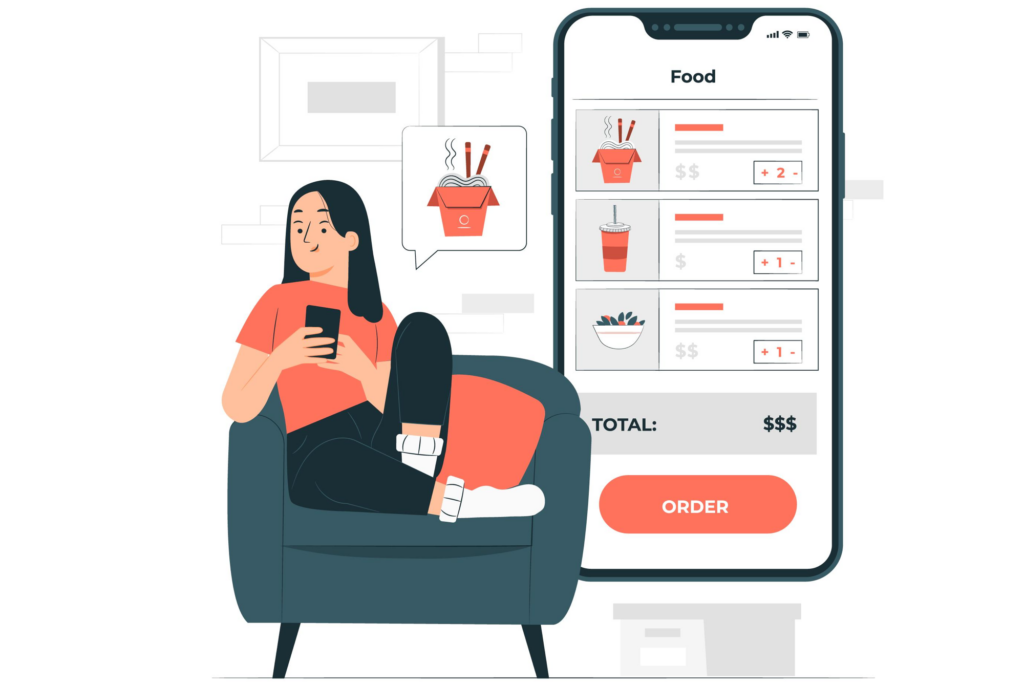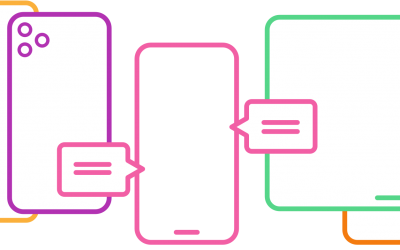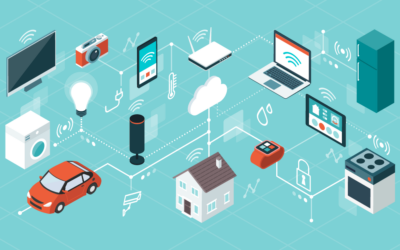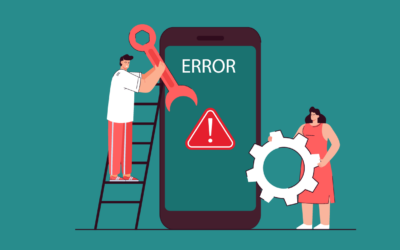Table of content
- Key Features of a Restaurant App
- POS System to Restaurant Mobile App
- Integration of Restaurant Apps with Third-Party Delivery Apps
- Restaurant Web Development- Online Ordering
- Integration of Restaurant App with Reserve with Google
- Restaurant Apps and IoT in Restaurant Operations
- Krasamo Restaurant Mobile App Services
Integrating mobile technologies into our daily lives offers restaurants an invaluable opportunity to establish a presence on consumer devices through mobile applications, thereby enhancing the overall dining experience for their users.
Developing a restaurant mobile app can significantly differentiate a business by elevating the customer experience. This is achieved through various functionalities, including the convenience of making reservations, placing orders, processing payments, and managing order transactions directly from the app.
Moreover, a restaurant mobile app is a powerful tool for gathering essential data, which can be leveraged for more effective marketing strategies. It also plays a crucial role in cultivating customer loyalty, improving operational efficiency, and broadening the restaurant’s reach to a wider audience.
The development process of a restaurant mobile app involves steps akin to those used in creating any other mobile application. This process necessitates thoroughly considering specific factors unique to the restaurant industry, ensuring the app not only meets but exceeds the expectations of its users.
Key Features of a Restaurant App
The essence of restaurant mobile app development lies in crafting features that enhance the user experience and distinguish the restaurant from its competitors.
It’s crucial to pinpoint the right mix of features based on customer preferences and the restaurant’s specific needs. Here are some suggested features for an In-house dining app:
1. Menu Browsing: Enhance the customer’s interaction with your restaurant by allowing them to explore a digital menu, complete with detailed descriptions and current prices of dishes. This dynamic menu can be quickly updated to reflect changes or specials, providing a flexible and personalized experience.
2. Table Reservations: Customers can conveniently reserve tables in advance, selecting the date, time, and preferred seating area, streamlining the reservation process. Also, the restaurant app integrates with real-time reservation networks like Reserve with Google or OpenTable.
3. Ordering Food: Empower customers to order directly from their devices for dine-in, takeaway, or delivery. This feature should be intuitive, offering a seamless ordering process.
4. Payment Integration: Incorporate various payment methods, such as credit/debit cards and digital wallets, through integrations with platforms like Stripe or Square. Also, consider including contactless payment options for diverse transaction preferences.
5. Loyalty Programs and Offers: Utilize the app to operate loyalty programs, offering rewards and exclusive deals to frequent customers. This can enhance customer retention and encourage repeat business.
6. Feedback and Ratings: Encourage customers to provide feedback and rate their dining experience. This feature is invaluable for maintaining high standards of quality and service.
7. Location-Based Services: Offer GPS navigation to guide customers to your restaurant’s location (Geolocation). For chain restaurants, suggest nearby branches, enhancing customer convenience. Learn more about geolocation apps.
8. Push Notifications: Use notifications to inform customers about new menu items, special events, or promotions, thus boosting engagement.
9. Customer Service: Incorporate features like chat support or a FAQ section to assist customers efficiently with their inquiries or concerns.
10. Order Tracking: Allow customers to track the status of their orders in real-time, providing transparency and improving the customer experience.
When building these features, consider the challenges of integrating with restaurant-specific software, such as POS systems, inventory management, and reservation systems. The design of the app’s user interface should be intuitive and easy to navigate while ensuring robust security measures are in place to protect data and privacy.
Moreover, the app must handle a high volume of users and transactions without compromising performance. Including functionalities for take-out orders and integrating with third-party delivery apps and other services can further enhance the app’s utility.
Many restaurant owners wonder: “Can I make an app for my restaurant?” The answer is a resounding yes. Developing a restaurant app is becoming increasingly affordable and is the best option to align your business objectives.
Even if your restaurant currently partners with delivery apps, continue exploring additional avenues such as Google reservations and other restaurant marketing solutions. It’s time to align, integrate, and meticulously manage all your systems for optimal performance and customer satisfaction.
POS System to Restaurant Mobile App
A Point of Sale (POS) system is pivotal in restaurant management. It’s a tool for processing sales and a comprehensive solution designed for efficient restaurant operations.
A POS system typically includes functionalities for order routing, inventory tracking, real-time order display, customer data management, employee scheduling, and sales reporting, all accessible from a single dashboard.
Some POS system examples are the following:
- Clover
- Toast
- Touch Bistro
- Square
Integrating these systems with a customized restaurant mobile app is where a Krasamo mobile developer comes into play. These professionals are adept at creating a seamless link between the mobile app and the POS system, ensuring efficient data synchronization and workflow.
The technical process involves close work with the chosen POS system’s APIs, understanding its documentation, and checking compatibility with third-party applications. Developers then obtain necessary API keys, crafting workflows and integrations that allow the restaurant app to communicate effectively with the POS system.
This integration brings substantial benefits to the restaurant’s operations. For instance, it streamlines the ordering process by directly integrating orders from the restaurant’s branded app and third-party platforms like Uber Eats, Doordash, and Grubhub into the POS system. This eliminates double entry of orders, reducing errors and enhancing the overall customer service.
A restaurant mobile app and POS system must integrate with Kitchen Display Systems (KDS).
A KDS called a back-of-house system is a software application displayed on a touchscreen in the kitchen that interfaces with the restaurant’s POS system (front-of-house system).
It displays incoming orders, tracks the progress of each dish, and updates the front-of-house staff and customers in real-time. This system improves order accuracy, enhances efficiency by streamlining kitchen workflows, and improves customer experience by providing real-time status updates.
Moreover, the integrated system greatly improves the user experience. Customers enjoy faster service and accurate order fulfillment, leading to increased satisfaction. This integration facilitates a smoother operation on the backend, with real-time updates and reduced manual intervention.
Ensuring compliance with industry standards, such as PCI DSS for secure payment processing, and implementing stringent data security measures are critical in this integration to safeguard customer information.
Integrating a restaurant’s POS system with a branded mobile app is crucial in modern restaurant management. It optimizes operational efficiency, enhances customer experience, and prevents the inefficiency of double-entering orders, thereby positioning the restaurant for success in a competitive marketplace.
Integration of Restaurant Apps with Third-Party Delivery Apps
Maximizing Market Reach through Third-Party Delivery Apps
In the competitive landscape of the restaurant industry, leveraging diverse channels is vital for effective marketing and revenue generation. Third-party delivery apps have become a crucial source of income for many restaurants.
For some establishments, beginning with sales through these platforms is more accessible, though it may become costly over time.
The primary advantage of a custom restaurant mobile app is the personalized experience it offers to customers, particularly the most loyal and profitable ones. However, third-party apps play a significant role in attracting new customers. Therefore, integrating your custom restaurant app with these third-party services is crucial.
Seamless Integration for Expanding Reach and Enhancing Efficiency
Seamless integration enables restaurants to accept and manage online orders from all locations where customers discover them. By connecting with third-party delivery apps, restaurants can broaden their reach and customer base, tapping into the convenience these platforms offer to users who prefer ordering from multiple restaurants through a single app.
Integrating your restaurant app with delivery apps is essential for efficiently servicing orders from these platforms. This integration offers several benefits:
- Improved Data Collection and Analysis: It enables a better understanding of customer preferences and demand, enabling menu adjustments and targeted marketing strategies.
- Access to Infrastructure and Networks: Integration provides access to established delivery networks, reducing the need for in-house logistics and associated costs.
- Enhanced Visibility and Marketing Opportunities: Being visible on popular delivery apps can significantly increase a restaurant’s exposure, particularly through app-based promotions and features.
- Valuable Customer Feedback: These platforms often facilitate customer reviews and feedback, which can be crucial for service improvement and reputation management.
- Streamlined Order Management: Orders from third-party apps are automatically added to the restaurant’s system, ensuring efficiency and reducing the risk of errors.
- Unified Order Handling: Manage orders from the mobile app, website, or POS and sync any changes with the delivery app to maintain consistency across platforms.
- Commission-Free Online Ordering: By adding a storefront to delivery platforms, restaurants can handle orders through their system while leveraging the delivery app for logistics only, often on a pay-per-delivery basis.
- Enhanced Customer Communication: Features like status updates, live tracking, and SMS notifications improve the customer experience by informing them in real-time.
Popular Delivery Apps for Integration
Some of the most well-known third-party delivery apps include DoorDash, Uber Eats, Instacart, Caviar, and Grubhub. Integrating these platforms can open new avenues for business growth and customer satisfaction.
Restaurant Web Development- Online Ordering
Krasamo specializes in crafting beautifully designed websites that are visually appealing and functional, aimed at boosting revenue and increasing restaurant profit margins. By incorporating catering and event management features, we expand your online presence, enabling the creation of new offerings and more engaging user experiences.
Central to our approach is the integration of a robust online ordering system. This system harmonizes the functionalities of a POS system, a custom mobile app, and a website, delivering a comprehensive solution that streamlines the ordering process from customer initiation to kitchen production.
One of the key aspects of this integration is connecting your website with the POS system. This connection synchronizes the menu across your restaurant’s mobile app and website. Such synchronization ensures consistency in the offerings presented to your customers and facilitates ease of updates and management.
Through this integrated web development approach, we aim to provide a seamless online ordering experience for your customers, enhancing the efficiency of order processing and contributing to the overall growth of your restaurant business.
Integration of Restaurant App with Reserve with Google
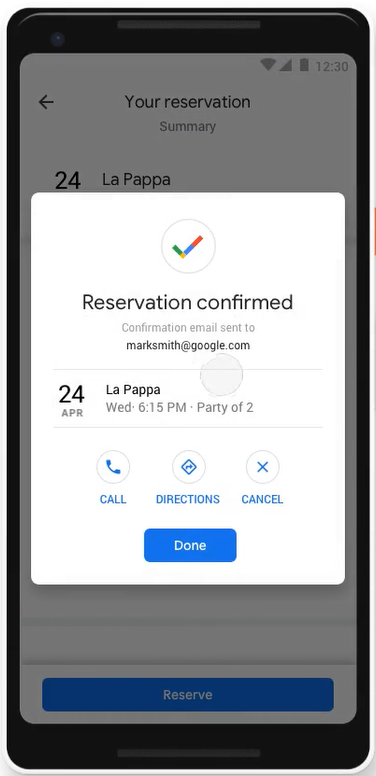
Reserve with Google is an innovative online reservation system that integrates seamlessly with a restaurant’s Point-of-Sale (POS) system and mobile app through API integration. This setup enables real-time synchronization of reservation data and table availability, ensuring consistency between Reserve with Google and the restaurant’s internal systems.
When a customer makes a reservation through Reserve with Google, the booking is instantly reflected in the restaurant’s POS system. If a selected timeslot becomes unavailable, the POS system communicates this change back to Reserve with Google, ensuring the online availability is always up-to-date.
Conversely, the restaurant can also update its availability in the POS, which is automatically synchronized with Reserve with Google, maintaining consistent booking information.
For customers, the convenience of Reserve with Google is unparalleled. Integrated into Google platforms like Maps, Search, and Assistant, it offers an accessible and user-friendly booking experience, available 24/7 without downloading an additional app. Customers benefit from immediate booking confirmations and have the ability to manage their reservations online effortlessly.
On the day of the reservation, the restaurant staff checks in the customer using their POS system. This action automatically updates the status in Reserve with Google, marking the customer as having arrived. Additionally, Reserve with Google provides valuable guest data, aiding restaurants in optimizing their operations and guest management.
Overall, integrating Reserve with Google with a restaurant’s POS and mobile app creates a streamlined and efficient reservation process, enhancing the restaurant’s and its customers’ experience. This real-time connection not only simplifies reservation management but also contributes to improved customer service and operational efficiency.
Restaurant Apps and IoT in Restaurant Operations
Restaurant apps, traditionally seen as customer-facing interfaces, increasingly embrace IoT technology, offering many applications beyond simple customer interaction. Integrating IoT with mobile apps empowers restaurant managers to operate with greater efficiency and oversight. Let’s explore some of the most critical capabilities of IoT in restaurant operations:
- Inventory Management: IoT-enabled smart shelves with weight sensors transform inventory tracking by monitoring stock levels in real time and automatically placing orders when supplies run low. This not only reduces waste but also ensures the constant availability of ingredients.
- Energy Management: IoT devices, such as smart thermostats and connected lighting systems, are key to optimizing energy use. They intelligently adjust based on restaurant hours, occupancy, and external weather conditions, effectively reducing energy costs.
- Equipment Maintenance: IoT sensors can continuously monitor the condition of kitchen equipment, including refrigerators and ovens. They alert staff to anomalies, like temperature fluctuations, helping to prevent equipment failures and costly repairs.
- Food Safety Compliance and Monitoring: IoT devices are crucial in maintaining food safety standards by consistently monitoring storage conditions, such as temperature and humidity. This ensures the freshness and safety of food, reducing the risk of spoilage and foodborne illnesses.
- Operational Efficiency and Waste Reduction: IoT technology extends to monitoring equipment usage, facilitating timely maintenance, and optimizing energy consumption. IoT-empowered kitchen appliances can also autonomously manage inventory, conduct performance analyses, and communicate with other devices, thus enhancing efficiency and minimizing waste.
By incorporating IoT into restaurant mobile apps, restaurant owners and managers gain a comprehensive view and control over their operations. This technological synergy enhances the restaurant’s operations’ efficiency and sustainability and significantly improves food safety and customer satisfaction.
Krasamo Restaurant Mobile App Services
At Krasamo, we offer a range of specialized services to enhance the digital experience of your restaurant:
- User Experience (UX) and User Interface (UI) Design: We focus on creating visually appealing and user-friendly designs that ensure an intuitive and engaging customer experience tailored to embody your brand’s unique character.
- Custom Mobile App Development (Front-End and Back-End): Our team excels in developing custom mobile applications, encompassing both the front-end for user interaction and the back-end for server and database management, ensuring a smooth, responsive, and robust app performance.
- Integration of Delivery App APIs with Your POS and Mobile App: We streamline the integration process, connecting your POS and mobile app with leading delivery app APIs. This facilitates efficient order handling, real-time synchronization, and expanded reach through popular delivery platforms.
- Menu Management Across Web and Mobile App, Synchronized with Third-Party Apps: Our services include seamless menu management capabilities. You can easily update and manage your menu across your website and mobile app, with automatic synchronization to third-party apps, ensuring consistent offerings across all platforms.
- IoT Development: Krasamo provides specialized IoT skills according to restaurant needs.

